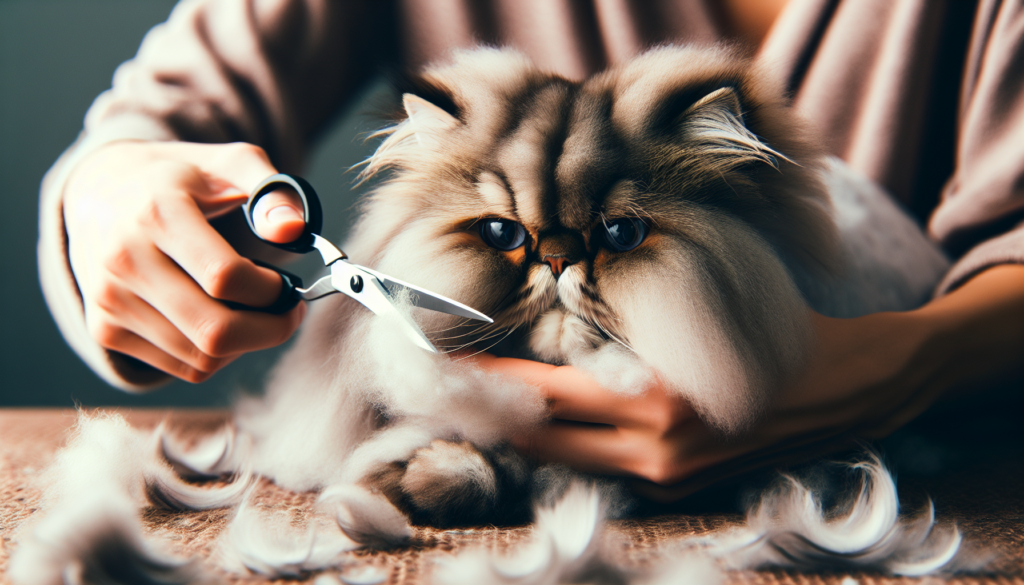So you’ve just brought home your new adorable Persian cat, but you’ve noticed that their long, luxurious fur requires some extra care. Don’t worry, we’ve got you covered! In this beginner’s guide, we’ll walk you through the steps of safely and effectively shaving your Persian cat. From choosing the right tools to ensuring a stress-free experience for your feline friend, we’ll provide all the tips and tricks you need to keep your Persian looking and feeling their best. Get ready to master the art of cat grooming!
Preparing for the Shave
Gathering the necessary tools
Before you begin shaving your Persian cat, it’s important to gather all the necessary tools. You will need a good quality pair of clippers with the appropriate blades for your cat’s fur. It is also essential to have a pair of nail clippers, a brush or comb suitable for Persian cat fur, cat shampoo, towels for drying, and treats to reward your furry friend during the grooming process.
Choosing the right location
Selecting the right location for the shave is crucial for both you and your cat. Find a quiet and well-lit area where you can comfortably groom your cat. It’s best to choose a spot where you can easily clean up any loose hair and where your cat feels secure and at ease. It might be helpful to use a non-slip mat or towel to provide stability for your cat during the grooming session.
Ensuring the cat is calm and comfortable
Before you begin the shaving process, it’s essential to make sure your cat is calm and comfortable. Create a calm environment by minimizing loud noises and distractions. Offer your cat their favorite blanket or bed to relax on. You can also play some soothing music or use calming pheromone sprays to help create a peaceful atmosphere. Taking the time to ensure your cat’s comfort will make the grooming experience more enjoyable for both of you.
Understanding the Persian Cat’s Coat
Learning about the Persian cat’s double coat
Persian cats have a unique and luxurious double coat that requires regular maintenance. Their topcoat is long and thick, while the undercoat provides insulation and protection. The combination of these two layers creates the distinctive appearance of their fur. understanding the characteristics of the Persian cat’s coat is essential to properly care for it.
Identifying potential coat issues
While Persian cats are known for their beautiful coats, they are also prone to certain coat issues. These can include tangles, mats, and excessive shedding. By regularly monitoring your cat’s coat, you can identify and address these issues before they become more significant problems. Being proactive in maintaining your cat’s coat will help keep it healthy and looking its best.
Recognizing the importance of shaving
Shaving your Persian cat’s coat has several benefits. It helps to prevent mats and tangles, reduces the risk of overheating during the warmer months, and makes grooming easier and more manageable. Shaving also gives you the opportunity to check for any skin issues or abnormalities that may be hidden under the fur. Understanding the importance of shaving will motivate you to incorporate it into your cat’s grooming routine.

Selecting the Right Time
Considering the cat’s age
When deciding when to shave your Persian cat, it’s important to take their age into account. Younger cats may be more energetic and curious, making it challenging to keep them still during the grooming process. Older cats, on the other hand, may have more sensitive skin or underlying health issues that could be aggravated by shaving. Choose a time when your cat is calm and relaxed to make the experience as comfortable as possible for them.
Factoring in the weather
The weather plays a significant role in determining when to shave your Persian cat. During hot and humid months, shaving can help keep your cat cool and prevent them from becoming overheated. However, it’s important to consider the climate in your area and ensure your cat is well-protected and comfortable after the shave. In colder months, you may want to delay shaving to allow your cat’s natural coat to provide insulation.
Taking note of the cat’s health
Before shaving your Persian cat, it’s vital to consider their overall health. If your cat has any pre-existing skin conditions, allergies, or is currently undergoing treatment, consult with your veterinarian before proceeding. Shaving may not be recommended in some cases or may require specific precautions to avoid any potential complications. Always prioritize your cat’s well-being and consult with a professional if you have any concerns about their health.
Trimming the Cat’s Nails
Gathering the appropriate tools
Before trimming your cat’s nails, gather the necessary tools. You will need a pair of cat nail clippers that are specifically designed for feline nails. Avoid using human nail clippers as they may not be as effective or safe. Have some styptic powder or cornstarch on hand in case you accidentally cut the nail too short and it starts bleeding. Additionally, prepare some treats to reward your cat after each successful nail trimming session.
Using proper techniques for nail trimming
Trimming a Persian cat’s nails may seem intimidating, but with the right technique, it can be a breeze. Gently hold your cat’s paw and use the clippers to carefully trim the curved end of each nail. Take care not to cut too close to the quick, which is the sensitive area that contains blood vessels. It’s better to trim smaller portions gradually rather than risk cutting too much at once. If you are unsure, consult with a professional groomer for guidance.
Ensuring the cat’s safety during the process
When trimming your cat’s nails, safety should be a top priority. Ensure that you have a secure grip on your cat’s paw to prevent accidental slips or injury. If your cat becomes anxious or resistant, take a break and try again later when they are calm. If your cat is particularly sensitive or uncooperative, you may want to consider seeking the assistance of a professional groomer or veterinarian to ensure the process is done safely and efficiently.

Brushing the Cat’s Coat
Using the right type of brush or comb
When brushing a Persian cat’s coat, it’s crucial to use the right type of brush or comb. The dense and silky nature of their fur requires a comb or brush with wide-spaced teeth or bristles to effectively remove loose hair, tangles, and mats. Look for grooming tools specifically designed for Persian cats or long-haired breeds to ensure optimal results and prevent any discomfort or damage to the fur.
Removing tangles and mats
Regular brushing will help prevent tangles and mats in your cat’s coat, but if they do occur, it’s important to address them promptly. Use your fingers or a comb to gently separate the hair and work through the tangles, starting from the ends and working your way up. Be patient and avoid pulling or tugging on the fur, as this can cause discomfort or pain to your cat. If the tangles or mats are severe, consider seeking professional grooming assistance.
Preventing discomfort or pain
While brushing your cat’s coat, it’s essential to prioritize their comfort and prevent any discomfort or pain. Approach the brushing process with a gentle touch and in a calm manner. Take breaks if your cat becomes agitated or anxious, and use positive reinforcement, such as treats or praise, to reward them for their cooperation. Regular brushing sessions will help keep your Persian cat’s coat healthy and free from discomfort.
Bathing the Cat
Choosing a suitable cat shampoo
When bathing your Persian cat, it’s important to choose a cat shampoo that is gentle and specially formulated for feline use. Avoid using human shampoos or harsh chemicals that could irritate your cat’s skin. Look for shampoos that are hypoallergenic and free from artificial fragrances. Consulting with your veterinarian can also help ensure you select the right shampoo for your cat’s specific needs.
Providing a gentle and calm bathing environment
Creating a gentle and calm bathing environment is essential to reduce your cat’s anxiety and make the experience as pleasant as possible. Fill the sink or a shallow tub with warm water that is comfortable for your cat. Use a soft washcloth or your hand to wet and lather your cat’s fur with the shampoo, being careful to avoid the face and ears. Speak softly and provide reassurance throughout the process to help keep your cat calm.
Properly drying the cat after the bath
After bathing your Persian cat, it’s important to dry their fur thoroughly to prevent any skin issues or discomfort. Use a soft towel to gently remove excess water by patting and squeezing the fur. Avoid rubbing the fur vigorously, as this can cause tangles or damage. If your cat tolerates the noise, you can also use a low heat setting on a blow dryer to speed up the drying process. Ensure that the blow dryer is kept at a safe distance and that your cat remains calm and comfortable.
Choosing the Right Clippers
Understanding the different types of clippers available
When choosing clippers for shaving your Persian cat’s fur, it’s important to understand the different types available. There are electric clippers, which are suitable for larger cats or cats with thicker fur, and manual clippers, which require hand-powered operation. Electric clippers offer convenience and speed, while manual clippers provide more control. Consider your cat’s size, coat thickness, and your own comfort level when selecting the right type of clippers for the task.
Considering the cat’s tolerance level
It’s important to consider your cat’s tolerance level when selecting clippers. Some cats may be more sensitive or anxious around the noise and vibrations caused by electric clippers. In such cases, manual clippers may be a better option as they produce less noise and offer more control. If your cat is comfortable with grooming tools and doesn’t mind the noise, electric clippers can be a great time-saving option. Always prioritize your cat’s comfort and well-being when making this decision.
Consulting with a professional groomer or vet
If you are unsure about which clippers to choose, it’s always a good idea to consult with a professional groomer or veterinarian. They can provide valuable insights and advice based on their experience with Persian cats. They may also be able to recommend specific brands or models that are known for their effectiveness and safety. Seeking professional guidance will help ensure that you select the right clippers for your cat’s needs.
Getting the Cat Accustomed to Clippers
Introducing the clippers gradually
Before starting the shaving process, it’s important to introduce your cat to the clippers gradually. Allow your cat to explore and sniff the clippers while they are turned off. Offer treats and positive reinforcement to create a positive association with the clippers. Gradually introduce the sound and vibrations of the clippers, taking it slow and providing treats and praise throughout the process. This gradual introduction will help your cat become more comfortable and less anxious around the clippers.
Offering positive reinforcement
Positive reinforcement is an effective way to encourage your cat to tolerate and cooperate during grooming sessions. Offer treats, praise, and gentle petting as rewards for good behavior. By associating the grooming process with positive experiences, your cat will be more likely to stay calm and relaxed. Be patient and understanding, as it may take time for your cat to adjust to the clippers and grooming routine. Consistency and positive reinforcement will help create a stress-free grooming experience for both of you.
Keeping the sessions short and stress-free
When getting your cat accustomed to clippers, it’s important to keep the sessions short and stress-free. Start with brief sessions and gradually increase the duration as your cat becomes more comfortable. Pay attention to your cat’s body language and cues, and if they seem agitated or stressed, take a break and try again later. Remember, grooming should be a positive and bonding experience between you and your furry friend. By keeping the sessions short and stress-free, you will help build trust and make the overall grooming process more enjoyable for your cat.
Starting the Shaving Process
Creating a calm and safe environment
Before you begin the shaving process, create a calm and safe environment for both you and your cat. Ensure that you have all the necessary tools within reach and that the area is well-lit. Use a non-slip mat or towel to provide stability for your cat. Minimize distractions and loud noises that could startle or stress your cat. Keeping the environment calm and safe will help set a positive tone for the grooming session.
Using an appropriate clipper blade
Using the right clipper blade is crucial for a successful shave. Persian cats have thick fur, so it’s best to use a blade with a higher number, such as a 3 or 4F. This will allow you to remove the desired amount of fur while minimizing the risk of cutting the skin. It’s important to read the instructions for your specific clipper model to ensure you are using the appropriate blade for your cat’s coat. Always prioritize your cat’s safety and comfort during the shaving process.
Following the direction of hair growth
When shaving your Persian cat, it’s important to follow the direction of hair growth. This will help prevent irritation, ingrown hairs, and discomfort. Start shaving in small sections, using gentle and steady strokes. Be cautious around sensitive areas such as the face, ears, and paws. Take breaks as needed and offer treats and praise to reward your cat for their cooperation. By following the direction of hair growth, you will achieve a smooth and even shave while keeping your cat comfortable.
Completing the Shave
Giving the cat breaks and rewards as needed
Completing the shave can be a lengthy process, so it’s important to give your cat breaks and rewards as needed. Shaving a Persian cat’s coat can take time, especially if there are any tangles or mats to work through. Pay attention to your cat’s behavior and body language, and if they show signs of stress or fatigue, take a break. Offer treats, praise, and gentle petting during the breaks to keep your cat’s spirits up and make the process more enjoyable for them.
Checking for missed spots or uneven areas
After completing the shave, take the time to check for any missed spots or uneven areas. Running your hands gently over your cat’s coat can help you identify any missed fur or areas that need further trimming. Use your clippers or scissors to touch up any spots that may have been missed during the initial shave. Be cautious and take your time to avoid any accidental cuts or injury. Ensuring a thorough and even shave will help your cat maintain their beautiful appearance.
Ensuring the cat’s comfort and safety throughout the process
Throughout the shaving process, it’s crucial to prioritize your cat’s comfort and safety. Pay attention to their body language and cues, and if they seem distressed or uneasy, take a break or stop the grooming session altogether. Always use gentle and cautious movements to avoid any accidental nicks or cuts. Remember to provide treats, praise, and reassurance to make the experience as positive as possible for your cat. By ensuring your cat’s comfort and safety, you will create a bond of trust and make future grooming sessions easier.

